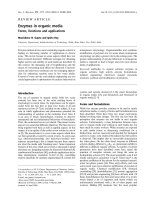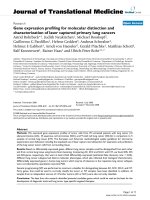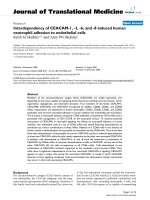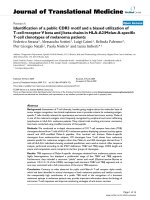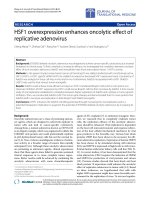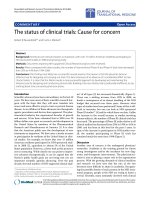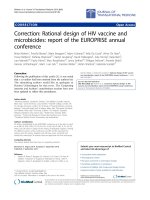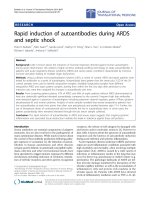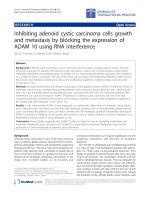báo cáo hóa học:" Biologically Inspired Signal Processing: Analyses, Algorithms and Applications" potx
Bạn đang xem bản rút gọn của tài liệu. Xem và tải ngay bản đầy đủ của tài liệu tại đây (108.97 KB, 3 trang )
This Provisional PDF corresponds to the article as it appeared upon acceptance. Fully formatted
PDF and full text (HTML) versions will be made available soon.
Biologically Inspired Signal Processing: Analyses, Algorithms and Applications
EURASIP Journal on Advances in Signal Processing 2012,
2012:28 doi:10.1186/1687-6180-2012-28
Elias Aboutanios ()
Steve McLaughlin ()
Yannis Kopsinis ()
Raviraj Adve ()
ISSN 1687-6180
Article type Editorial
Submission date 14 April 2011
Acceptance date 14 February 2012
Publication date 14 February 2012
Article URL />This peer-reviewed article was published immediately upon acceptance. It can be downloaded,
printed and distributed freely for any purposes (see copyright notice below).
For information about publishing your research in EURASIP Journal on Advances in Signal
Processing go to
/>For information about other SpringerOpen publications go to
EURASIP Journal on Advances
in Signal Processing
© 2012 Aboutanios et al. ; licensee Springer.
This is an open access article distributed under the terms of the Creative Commons Attribution License ( />which permits unrestricted use, distribution, and reproduction in any medium, provided the original work is properly cited.
Biologically Inspired Signal Processing: Analyses, Algorithms and
Applications
Elias Aboutanios
1
, Steve McLaughlin
2
, Yannis Kopsinis
3
, and Raviraj Adve
4
1
The school of Electrical Engineering and Telecommunications, the University of New south Wales, Sydney, Australia
2
The Institute for Digital Communications, the University of Edinburgh, Edinburgh, The United Kingdom
3
The Department of Informatics and Telecommunications, The University of Athens, Athens, Greece
4
The Edward S. Rogers Sr. Department of Electrical and Computer Engineering, The University of Toronto, Toronto, Canada
Corresponding Author:
SM:
YK:
RA:
“How fleeting are the wishes and efforts of man! How short is his time! And consequently how poor
will his products be, compared with those accumulated by nature during whole geological periods.
Can we wonder, then, that nature’s productions should be far ‘truer’ in character than man’s
productions; that they should be infinitely better adapted to the most complex conditions of life, and
should plainly bear the stamp of far higher workmanship?” – Charles Darwin, The Origin of
Species.
Many of the problems that are encountered in Engineering have been solved in nature. In their
quest for survival species have developed ingenious solutions to these problems over millions of
years. As Darwin noted, these solutions that natural evolutionary processes have and are still in
the process of perfecting, are in most cases far superior to what we can achieve with our current
engineering knowledge and methods. This should come as no surprise when one considers the
power of natural selection and the vast time span and enormous scale of possibilities that it
operates over.
The superiority and inspirational qualities of naturally evolved solutions certainly hold true in
the field of signal processing. In their quest for survival within their natural environment, living
organisms must sense this environment, which they carry out using visual, auditory, tactile,
olfactory and gustatory sensors. They must then process the acquired signals and respond to the
cues they extract from them. Often these signals originate from the environment, but many
organisms have also evolved the ability to produce stimuli or transmit signals that permit them
to probe their surroundings. Thus living creatures have not only acquired advanced signal
processing systems but have also achieved adapted waveform designs that, combined with the
sensors and signal processing systems, lead to astounding levels of performance.
Consider, for instance, the problems of navigation and object detection, localisation and tracking.
Radar and Sonar provide solutions to these problems and have become essential to the
functioning of our society. While these relatively new technologies may arouse the wonder of
people at the capabilities of humans, they nonetheless pale in comparison to the achievements of
bats in these domains. This is even more amazing when one remembers that bats have, for
millions of years, been employing ultrasonic waves to navigate, forage, locate and hunt their prey
with great efficacy. That they do this with great success is a matter that is crucial for their
survival.
As we improve our knowledge of our natural environment and continually discover the wonders
it has evolved, it is important to draw inspiration from it. Understanding how nature implements
what it has perfected over such a long time, what solutions it has selected and those it has
discarded, will surely lead to significant advances in Signal Processing Research. These
observations not only apply to the highly advanced signal processors, but also to the sensors as
well as the waveforms that are exquisitely adapted to their purpose and in many cases amount to
optimally integrated signal processing systems. The papers that are published in this special
issue describe research results in sensors, signals and signal processing algorithms that are
inspired by naturally evolved analogues.
Many animals depend for their survival on detecting and locating objects, whether these objects
are obstacles for navigation or prey that is hunted. Dolphins are known to have evolved highly
advanced detectors that are capable of discriminating objects both below the surface and on the
seabed. Bio-inspiration is used in paper (484619) to improve the performance of man-made
sonar in the detection of marine cables by adopting dolphin-like wideband sonar pulses. In
addition to radar and sonar, biologically inspired waveform designs can play an important role in
many areas such as Ultrasound Contrast Imaging (UCI). However, these waveforms often consist
of short duration pulses that require localised processing. The Discrete Fourier Transform (DFT)
is a global transform, and the performance of DFT-based algorithms suffers when they are
applied to time-varying and non-stationary signals such as those encountered in biological
systems. These issues are examined in the next three papers. The authors of (146175) present a
Bayesian framework that is capable of estimating the signal parameters and which significantly
outperforms DFT-based techniques. In (532349) the authors use relevance analysis of random
bio-signals to identify pathologies; their sample application is the diagnosis of obstructive sleep
apnea. In (284791) the application is automatic speech recognition based on phoneme
classification. The authors develop an evolution-based spline functions approach as the fitness
measure leading to an optimized filterbank for phoneme classification.
The efficient waveform designs found in living organisms are matched by equally well-adapted
biological sensors. The work reported in article (806406) is concerned with autonomous
underwater vehicles where an advanced array of artificial hair-cell flow sensors is developed
that, with the aid of a specialized signal-processing unit, is imitating the sophisticated near-field
sensing capability of fish.
Vision is arguably the most important and heavily relied upon sensory system in living
organisms. Furthermore, its amazing capabilities are leaps and bounds above anything currently
achievable by technological means. Therefore, it is hardly surprising that it has and continues to
be an important source of bio-inspiration. In article (781561) the authors draw on the human
visual system for inspiration to enhance the measurement of object motion. They demonstrate
that the developed framework is capable of dealing with real image sequences. Articles (101428),
(841078) and (145232) apply knowledge and models of the visual system in robotics. In
(101428) the author presents a new object categorization method that uses a biologically
motivated codebook selection approach to break the image into its constituent objects and
background. In paper (841078) the authors study social robots that are intended to interact with
humans. They develop an object-based attention mechanism that is able to focus the resources of
the robot to the object that is relevant to the current task. Article (145232) applies bio-
inspiration from the visual system to advance the area of autonomous underwater vehicles and
robots respectively. In particular, a visual landmark detection system is developed by modelling
object shapes as cylinders inspired by Marr's visual theory.
The inspiration that can be drawn from living organisms is by no means limited to their organs
or subsystems. External behaviour, whether individual or group based, has also been evolving to
serve the species’ survival. Therefore, in article (341836) a novel clustering-based non-coherent
ultra wide band (UWB) detector is proposed which is relying on a biologically inspired Particle
Swarm Optimization approach.
Finally, in paper (973806), the authors look to the evolutionary principles themselves for
inspiration. Thus they formulate an efficient FPGA-based approach to optimize a wavelet
transform for improved image compression.
It is clear that like nature biologically inspired signal processing algorithms will continue to
evolve and we hope that this issue provides a useful snapshot of research in our community and
will inspire researchers to continue to explore this space.
